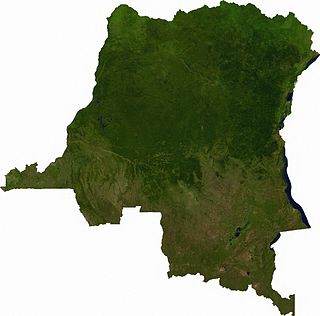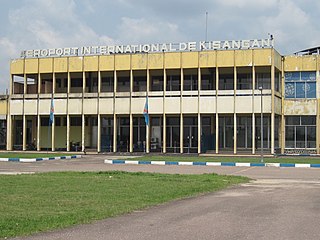
Ground transport in the Democratic Republic of the Congo (DRC) has always been difficult. The terrain and climate of the Congo Basin present serious barriers to road and rail construction, and the distances are enormous across this vast country. Furthermore, chronic economic mismanagement and internal conflict has led to serious under-investment over many years.

Kisangani is the capital of Tshopo Province, located on the Congo River in the eastern part of the central Congo Basin in the Democratic Republic of the Congo. It is the country's fifth most populous urban area, with an estimated population of 1,602,144 as of 2018, and the largest of the cities in the tropical woodlands of the Congo.
Wimbi Dira Airways was a scheduled and charter, passenger and cargo airline based in Kinshasa, Democratic Republic of the Congo. It serves the country's main cities. As of May 2014 all of their planes were reported to be in storage.

N'djili Airport, also known as N'Djili International Airport and Kinshasa International Airport, serves the city of Kinshasa and is the largest of the four international airports in the Democratic Republic of the Congo (DRC). It is named after the nearby Ndjili River.

Articles related to the Democratic Republic of the Congo include:
Mbandaka Airport is an airport serving the Congo River port of Mbandaka, capital city of the Équateur District in the Democratic Republic of the Congo. The runway is on the southeast side of the city.

Kisangani Bangoka International Airport is an airport serving Kisangani, Democratic Republic of the Congo. The airport is 12 kilometres (7.5 mi) east of the city. The Bangoka VOR/DME is 1.7 nautical miles (3.1 km) west of the airport.

Mbuji Mayi international Airport is an airport serving Mbuji Mayi, the capital of the Kasai-Oriental Province in the Democratic Republic of the Congo.

Kindu Airport is an airport serving the Lualaba River port of Kindu, Democratic Republic of the Congo.
Muanda Airport or Moanda Airport is an airport serving Muanda, an Atlantic coastal city in the Democratic Republic of the Congo.

Lodja Airport is an airport serving Lodja, a city in Sankuru Province, Democratic Republic of the Congo. It is 5 kilometres (3.1 mi) north of the city.

Gbadolite Airport is an airport serving Gbadolite, the capital of the Nord-Ubangi Province in the Democratic Republic of the Congo. The airport is at the village of Moanda, 6 kilometres (3.7 mi) southwest of Gbadolite.

Bunia Airport is an airport serving Bunia the capital of Ituri province, Democratic Republic of the Congo.
Kamina Airport is an airport serving Kamina, a city in Haut-Lomami Province, Democratic Republic of the Congo.

The Six-Day War was a series of armed confrontations between Ugandan and Rwandan forces around the city of Kisangani in the Democratic Republic of the Congo from 5 to 10 June 2000. The war formed part of the wider Second Congo War (1998–2003).
Camille Lembi Zaneli was the bishop of the Roman Catholic Diocese of Isangi, Democratic Republic of the Congo.
The following is a timeline of the history of the city of Goma, Democratic Republic of the Congo.
The following is a timeline of the history of the city of Kisangani, Democratic Republic of the Congo.
The Kisangani massacre occurred from May 13–15, 2002 in the city of Kisangani, Tshopo. After suppressing a mutiny, the Rally for Congolese Democracy started extrajudicial killings, lootings, and rape in the city, killing up to 183 people.

The Battle of Kisangani took place in March 1997 during the First Congo War. The rebels of the Alliance of Democratic Forces for the Liberation of Congo (AFDL), supported by the Rwandan Patriotic Front, took the city defended by the Zairian Armed Forces (FAZ) which was loyal to President Mobutu Sese Seko.














